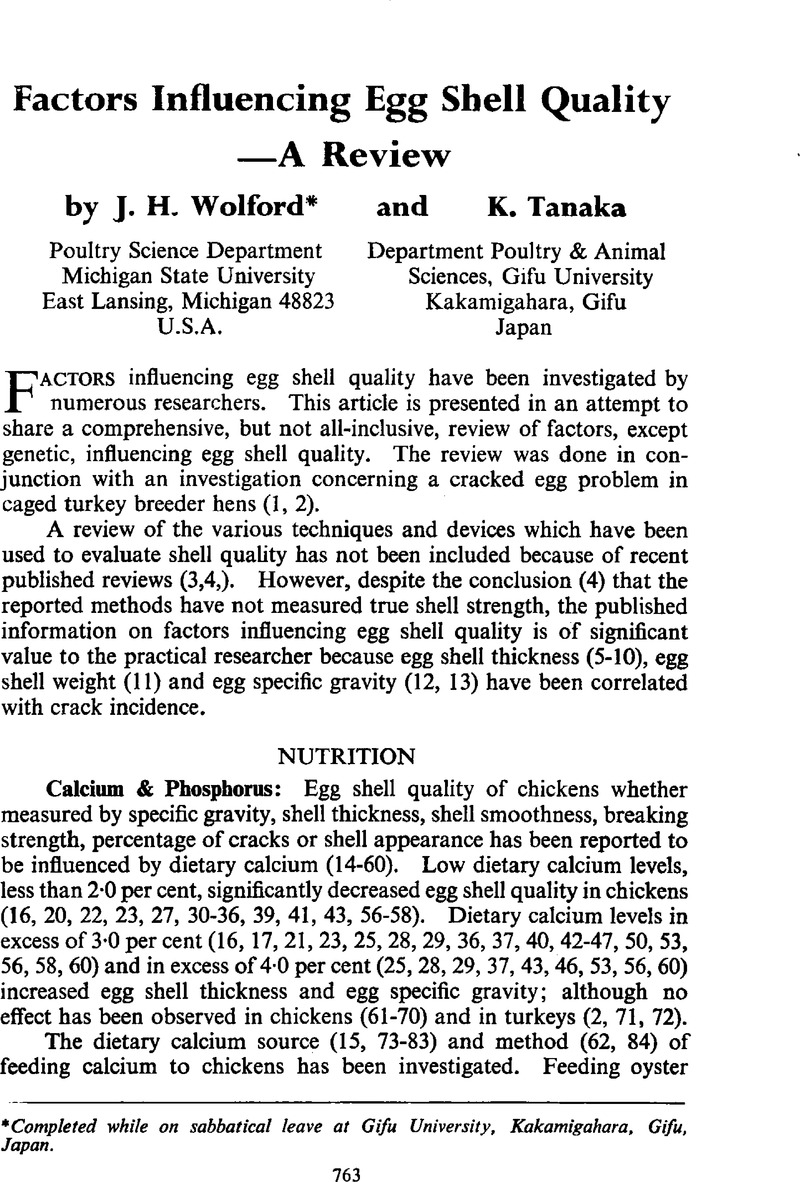Crossref Citations
This article has been cited by the following publications. This list is generated based on data provided by Crossref.
Marks, H.L.
and
Britton, W.M.
1972.
Egg Shell Quality of Selected Quail Lines.
Poultry Science,
Vol. 51,
Issue. 3,
p.
1054.
Foster, W. H.
and
Neil, E. L.
1972.
The effect of variation in egg numbers, body weight and egg weight upon shell thickness.
British Poultry Science,
Vol. 13,
Issue. 1,
p.
75.
Garrett, R.L.
McFarland, L.Z.
and
Franti, C.E.
1972.
Selected Characteristics of Eggs Produced by Japanese Quail (Coturnix Coturnix Japonica).
Poultry Science,
Vol. 51,
Issue. 4,
p.
1370.
Froning, G.W.
1973.
Effect of Temperature and Moisture on Breaking Strength of the Egg Shell.
Poultry Science,
Vol. 52,
Issue. 6,
p.
2332.
Potts, Philip L.
and
Washburn, K.W.
1974.
Shell Evaluation of White and Brown Egg Strains by Deformation, Breaking Strength, Shell Thickness and Specific Gravity.
Poultry Science,
Vol. 53,
Issue. 3,
p.
1123.
Mongin, P.
and
Sauveur, B.
1974.
Voluntary food and calcium intake by the laying hen.
British Poultry Science,
Vol. 15,
Issue. 4,
p.
349.
Roland, D.A.
Sloan, D.R.
Wilson, H.R.
and
Harms, R.H.
1974.
Relationship of Calcium to Reproductive Abnormalities in the Laying Hen (Gallus domesticus).
The Journal of Nutrition,
Vol. 104,
Issue. 8,
p.
1079.
Roland, D.A.
Sloan, D.R.
and
Harms, R.H.
1975.
The Ability of Hens to Maintain Calcium Deposition in the Egg Shell and Egg Yolk as the Hen Ages.
Poultry Science,
Vol. 54,
Issue. 5,
p.
1720.
Muir, F.V.
Harris, P.C.
and
Gerry, R.W.
1976.
The Comparative Value of Five Calcium Sources for Laying Hens.
Poultry Science,
Vol. 55,
Issue. 3,
p.
1046.
Place, T. Alan
and
Eroschenko, Victor P.
1976.
Strain Rate and Temperature Sensitivity of the Crack Initiation Force in Intact Japanese Quail Eggs.
Poultry Science,
Vol. 55,
Issue. 4,
p.
1273.
Britton, W.M.
1977.
Shell Membranes of Eggs Differing in Shell Quality from Young and Old Hens.
Poultry Science,
Vol. 56,
Issue. 2,
p.
647.
HAMILTON, R.M.G.
1978.
Observations on the Changes in Physical Characteristics that Influence Egg Shell Quality in Ten Strains of White Leghorns.
Poultry Science,
Vol. 57,
Issue. 5,
p.
1192.
Stoewsand, G. S.
Anderson, J. L.
Gutenmann, W. H.
and
Lisk, D. J.
1978.
Infuence of dietary calcium, selenium, and methylmercury on eggshell thickness in Japanese quail.
Bulletin of Environmental Contamination and Toxicology,
Vol. 20,
Issue. 1,
p.
135.
Hamilton, R. M. G.
Hollands, K. G.
Voisey, P. W.
and
Grunder, A. A.
1979.
Relationship Between Egg Shell Quality and Shell Breakage and Factors that Affect Shell Breakage in the Field–A Review.
World's Poultry Science Journal,
Vol. 35,
Issue. 3,
p.
177.
HESTER, PATRICIA Y.
WILSON, ELLEN K.
PIERSON, FRANK W.
and
FABIJANSKA, IRENA
1980.
Plasma Inorganic Phosphate, Calcium, and Magnesium Levels of Hens Which Laid Soft-Shelled or Shell-Less Eggs.
Poultry Science,
Vol. 59,
Issue. 10,
p.
2336.
Hamilton, R.M.G.
and
Thompson, B.K.
1980.
Effects of Sodium Plus Potassium to Chloride Ratio in Practical-Type Diets on Blood Gas Levels in Three Strains of White Leghorn Hens and the Relationship Between Acid-Base Balance and Egg Shell Strength ,.
Poultry Science,
Vol. 59,
Issue. 6,
p.
1294.
HAMILTON, R.M.G.
and
CIPERA, J.D.
1981.
Effects of Dietary Calcium Levels During the Brooding, Rearing, and Early Laying Period on Feed Intake, Egg Production, and Shell Quality of White Leghorn Hens.
Poultry Science,
Vol. 60,
Issue. 2,
p.
349.
WASHBURN, K.W.
BRAH, G.S.
and
MARKS, H.L.
1981.
Selection for Egg Mass in the Domestic Fowl.
Poultry Science,
Vol. 60,
Issue. 8,
p.
1788.
WILSON, ELLEN K.
HESTER, PATRICIA Y.
PIERSON, FRANK W.
and
FABIJANSKA, IRENA
1981.
Production Profile and Organ Weights of White Leghorn Hens Which Lay Soft-Shelled and Shell-Less Eggs.
Poultry Science,
Vol. 60,
Issue. 10,
p.
2356.
GARLICH, J.D.
1982.
Introduction.
Poultry Science,
Vol. 61,
Issue. 10,
p.
2004.



